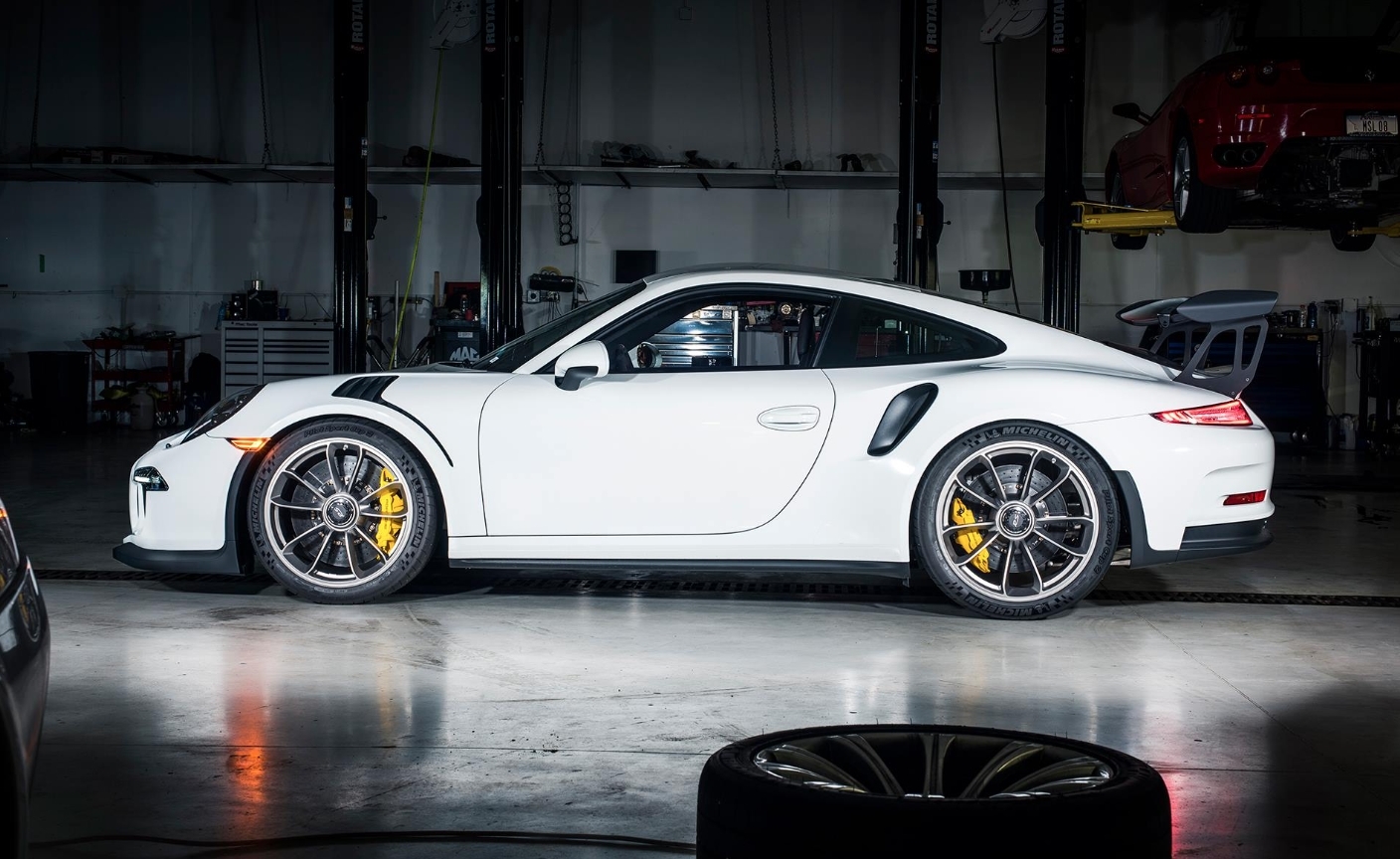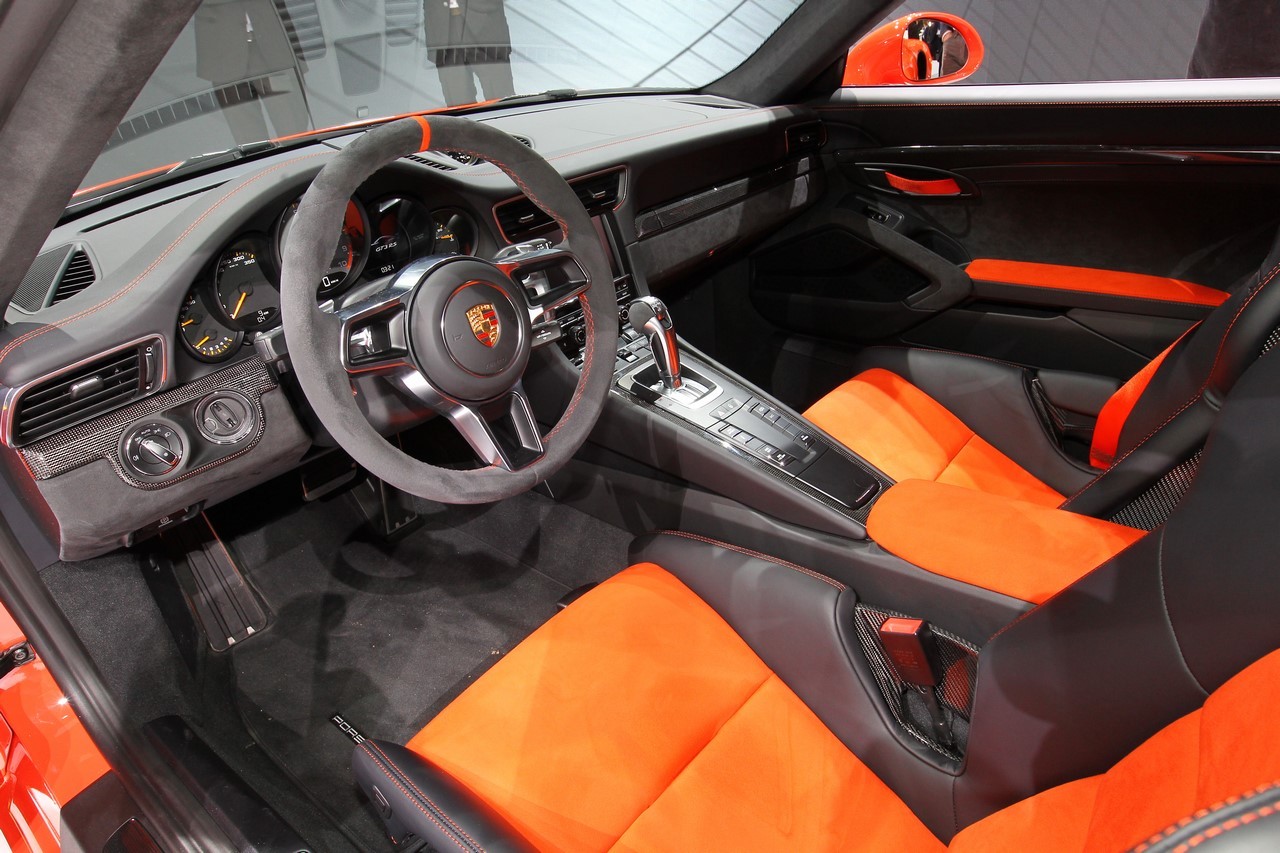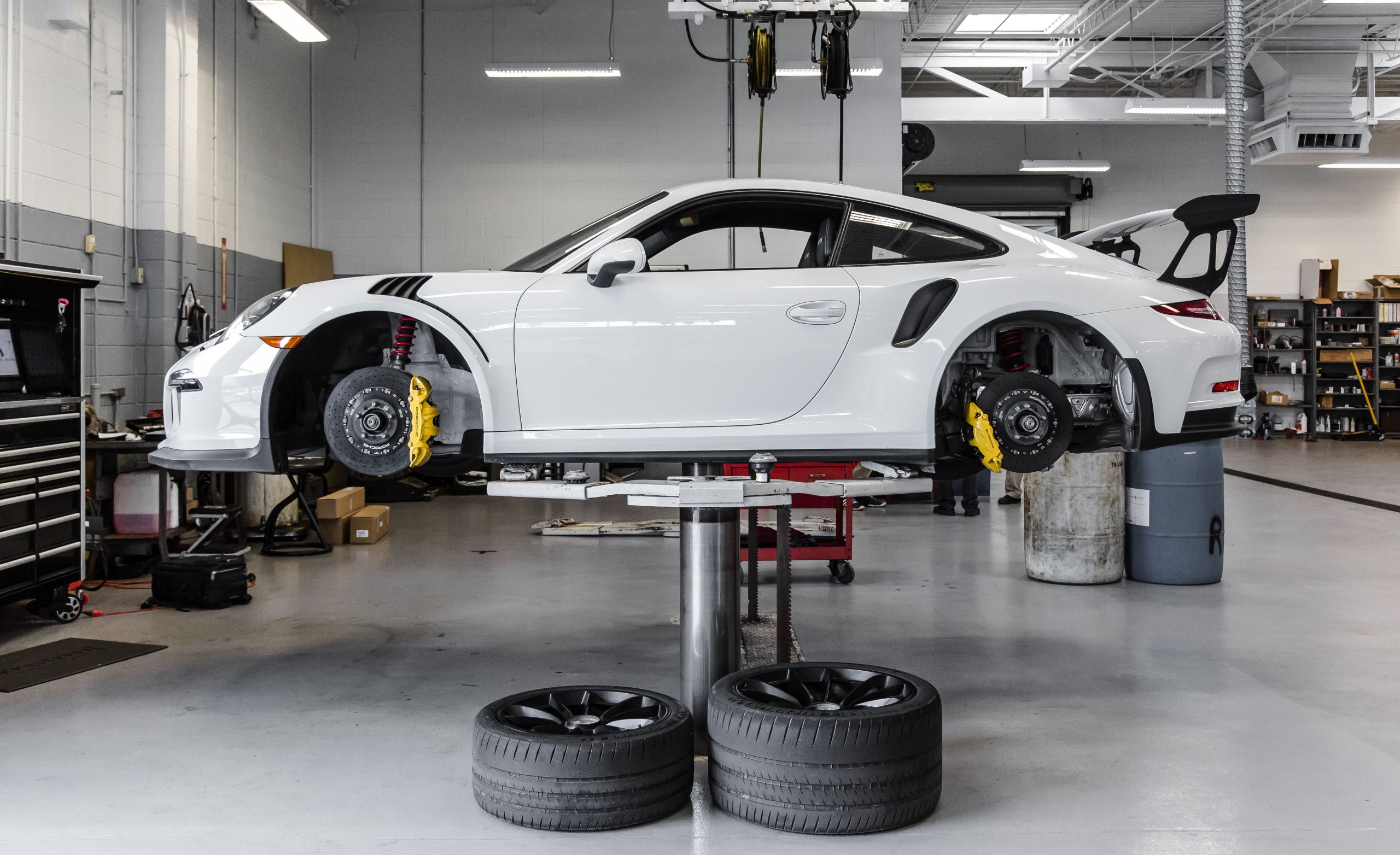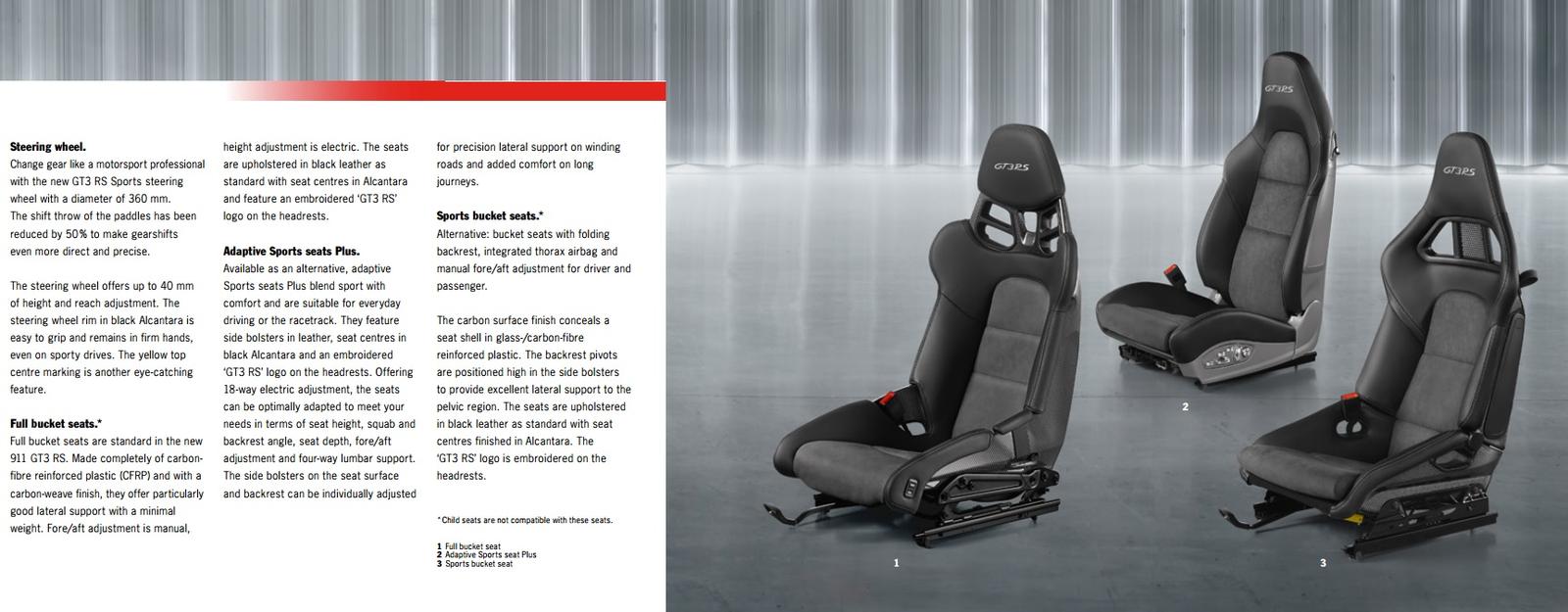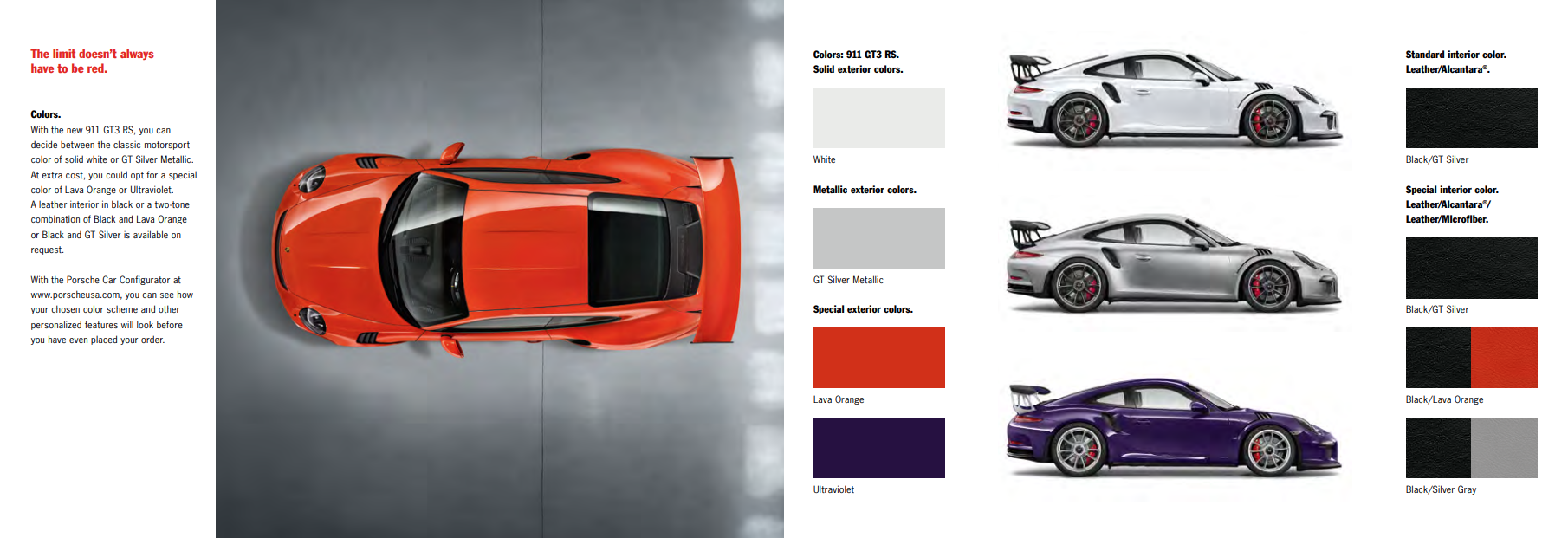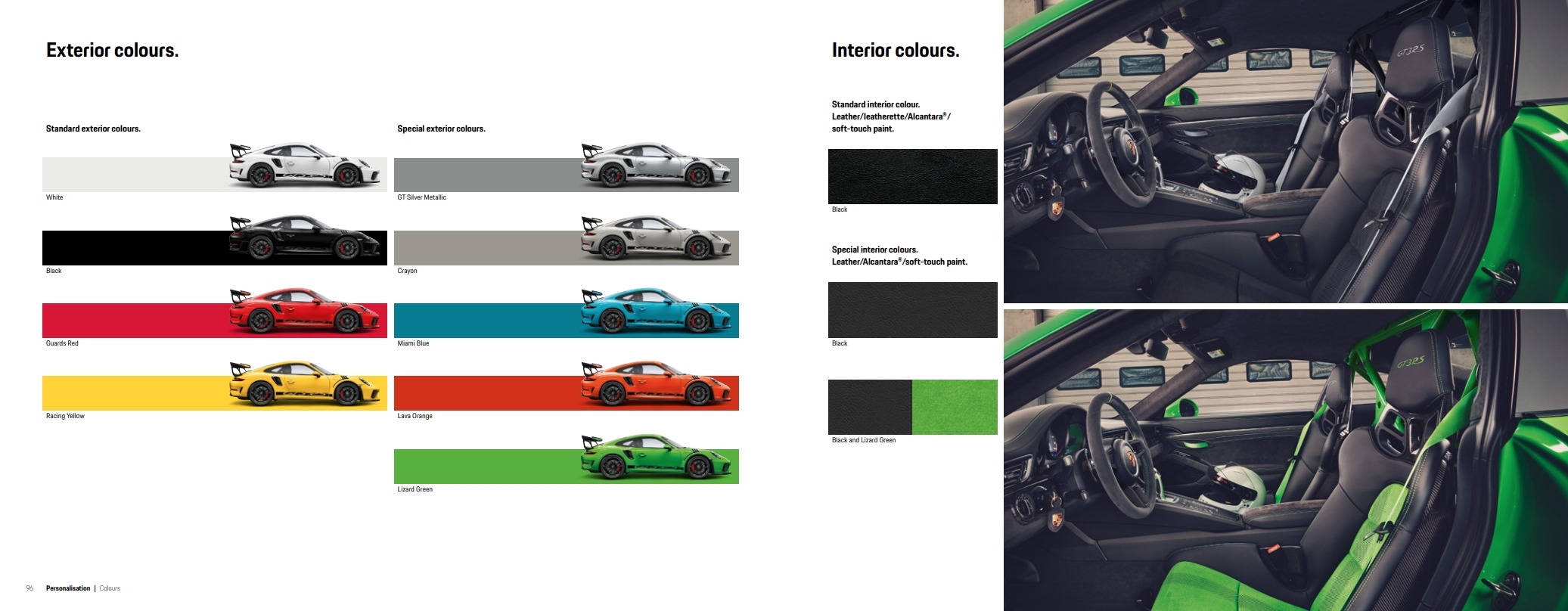The introduction of the Porsche 991.1 GT3 RS took the supercar world by storm. It replaced the 997.2 GT3 RS on an entirely new 991 chassis. It is regarded as one of the most hardcore street legal production cars around with Porsche's trusted reliability.
Each time a new GT3 RS is released, it sets the bar high for the successor to follow.
Slotting in as the big brother to the lesser expensive GT3, the GT3 RS is a car meant for drivers that are serious about lap times.
It features a 4.0 liter engine that pushes out 500 hp, versus 3.8 liters and 475 hp in the GT3. The RS engine revs up fast, helped by light titanium rods. Its middle titanium exhaust makes a very loud sound near the high 8800-rpm redline.
The GT3 RS has moved away from the manual transmission option, and now exclusively comes equipped with Porsche's exceptional PDK dual-clutch transmission, which is renowned for its seamless gear shifting and performance capabilities.
When you see a GT3 RS, you will not mistake it for a standard GT3. Immediately, you will notice the wider track, large rear wing, and more aggressive bodywork. Carrying on the tradition of high-performance GT3 RS models that began with the 996 generations in 2003 (not available in the U.S.), this newest iteration, like its predecessors, enhances track performance through increased tire grip and extensive aerodynamic improvements.
It comes with a wider body than the 911 Turbo models, making it 1.1 inches wider than the GT3. Porsche also changed the GT3 RS to use the rear fender ducts for air intake, which are used for intercoolers in the Turbo version.
The RS includes a magnesium roof and carbon-fiber front fenders, trunk lid, and rear engine cover. The front splitter, the ducktail-like engine cover, and the huge adjustable rear wing over five feet high are all part of the improved aerodynamics. These changes create three times more downforce than the GT3.
Inside the GT3 RS interior, you will find that it has the same dashboard as all other 991.1 911s, but a key difference is the Alcantara steering wheel and the carbon fiber racing seats that were also in the Porsche 918 hypercar. Although some came with comfort seats, the racing seats were the one that was most desirable.
The 991.1 GT3 RS's driving dynamics were a much more drastic improvement over the 997.2 GT3 RS it replaced.
Driving the GT3 RS on public roads can be a bit disappointing, as you won't be able to truly experience its full capabilities. This makes you more eager to take it to a racetrack and uncover its true potential. However, the GT3 RS surprisingly doesn't demand many compromises compared to the standard GT3. Although it might be slightly noisier and wider, the car still offers a comfortable ride, and the PDK gearbox performs seamlessly.
It features a more advanced and sophisticated drivetrain, which results in a smoother and more controlled driving experience.
Some of the competitors to the GT3 RS were the Ferrari 488 GTB, Lamborghini Huracan, and the McLaren 570S. The Porsche is the only one that is the most track-focused and hard-core that most resembles a street-legal race car out of the competition.
Overall, the GT3 RS is an incredible performance car, and those that buy one are most likely track enthusiasts you will not regret buying one.
Model Changes (Breakdown by Year)
2015 Porsche GT3 RS
The 2015 model was the first year of the 991.1 GT3 RS, which replaced the 997.2 GT3 RS.
Featuring a 4.0-litre engine that produces 500 hp and 340 lb-ft of torque.
As usual for Porsche, the design is based on function, and this feature helps push the front wheels down for better grip. A standout feature is the special air vents in the front wheel arches that reach the top part of the sides, just like a real race car.
The starting base price was around $176,000 slotting it right with the Ferrari 488 GTB, Lamborghini Huracan, and the McLaren 570s.
2016 Porsche GT3 RS
For the 2016 GT3 RS, everything remained the same with no changes.
2017 Porsche GT3 RS
No GT3 RS was produced for the year 2017.
That is because the 991.1 GT3 RS was in anticipation of the mid-life cycle update that came in 2018.
2018 Porsche GT3 RS
In 2018, the Porsche 991.2 GT3 RS was launched as an updated version. In short, an already great car became even better.
This is the best 911 without turbochargers. Almost all 911 models use turbocharging for more power and less CO2, but the GT3 and GT3 RS stay naturally aspirated. This gives more accurate power, higher RPMs, and an exciting sound.
It now comes with 513 hp (38 hp more than the 991.1 GT3 RS) and 347 lb-ft of torque, providing increased performance and quicker acceleration for an even more exciting driving experience.
The most noticeable difference is the body, which is wider, has more openings and has larger spoilers. It shares its body with the 911 Turbo, which is why it has cooling vents in the rear arches. These vents were designed for the Turbo's intercoolers, but in the GT3 RS, they supply air to the big airbox at the back.
The air ducts inside the car make the intake sound really amazing. The front part is wider than the Turbo, and it looks like a race car with its tilted position, thanks to the new 21-inch rear wheels and 20-inch front wheels.
The suspension is more advanced than the standard GT3, the aero kit produces increased downforce, and the 4.0-liter flat-six engine provides additional power and torque. This engine is closely connected to the one used in the 911 GT3 Cup race car.
Base price started at $188,000 ($12,000 more than the pre-facelift GT3 RS).
Porsche 991 GT3 RS Common Problems
The Porsche 991 GT3 RS is regarded as a supercar that is not only reliable but also one of the more hardcore track and street machines on the market.
Many people have driven their Porsche GT3 RS for extended distances, some even exceeding 80,000 miles, proving its reliability.
This breaks the traditional belief that supercars are inherently unreliable.
However, it is essential to keep in mind that all cars, even supercars, can have issues and it is crucial to perform a Pre-Purchase Inspection (PPI) from an authorized dealer or experienced independent mechanic to reveal all issues.
Fingerprint bearing failure: Earlier models of the 991 GT3 RS experienced engine failures due to faulty connecting rod bearings. Porsche addressed this issue by replacing the affected engines and updating the bearings in newer models.
Intermediate Shaft (IMS) bearing failure: Although more prevalent in earlier generations of the Porsche 911, some GT3 RS models have experienced IMS bearing failure, which could lead to catastrophic engine damage. Porsche has made significant improvements in recent years to address this issue.
Coolant leaks: Some GT3 RS engines have been reported to suffer from coolant leaks, mainly due to cracked coolant lines or faulty connections. Regular inspection and maintenance can help prevent this issue.
Overheating issues: There have been reports that the GT3 RS can sometimes face overheating problems, especially during extended periods of hard driving or in hot climates. Ensuring proper cooling system maintenance and using high-quality engine oil can help mitigate this issue.
Recalls
2016 GT3 RS vehicles
The Child Restraint System (CRS) instructions (Recall no. 19V875000)
The Child Restraint System (CRS) instructions within the Owner's Manual may not provide enough specificity for proper installation.
2016 GT3 RS vehicles
Air bags: Frontal: Passenger side: Inflator module (Recall no. 17V134000)
The passenger frontal air bag inflator initiator may fail to ignite during a crash.
2016 GT3 RS vehicles
Passenger Frontal Air Bag may not Deploy (Recall no.17V134000)
If the air bag inflator initiator fails to ignite, the passenger frontal air bag will not deploy, increasing the risk of injury in the event of a crash. This recall affected 2016 GT3 RS vehicles.
2018 GT3 RS vehicles.
Air Bags (Recall no.19V179000)
The side air bag impact sensors may not have been properly tightened to the vehicle. This recall affected 2018 GT3 RS vehicles.
Maintenance and Ownership Costs
In comparison to other supercars, the Porsche GT3 RS is known for its relatively minimal maintenance needs.
However, it is important to remember that regular maintenance and repairs will still be necessary, and the costs can vary depending on whether you take your car to a dealer or an independent mechanic.
Here is the suggested service schedule and intervals per Porsche:
Annual Maintenance or Every 6K Miles:
- Vehicle Inspection
- Change engine oil and filter
- Update or replace maintenance items based on inspection
- Replace engine air intake filters (GT3 RS)
- Add the following maintenance items to the annual service, based on the time or mileage intervals shown below:
Additional Maintenance Every 12K or 2 years:
- Replace Spark Plugs
- Replace brake fluid
- Replace cabin pollen filter
- Replace cabin pre-filter element
- Replace engine air intake filters
Additional Maintenance Every 24K or 4 Years:
- Replace drive belt
Additional Maintenance Every 48K or 6 years:
- Replace PDK clutch fluid
- Clean throttle body
Additional Maintenance Every 96K or 12 years:
- Replace manual transmission fluid
- Replace PDK transmission oil
Here is a rough estimate of typical service costs associated with the Porsche GT3 RS:
- Oil Change - As low as $300 for independent mechanics and $480 for dealers.
- Minor Service - Typically includes oil change, cabin filters, and engine filters. The cost from a dealer is around $1,500
- Major Service - Typically includes all the above plus spark plugs, brake flush, trans flush, expect about $2,500 from a dealer.
- Tires - A set of high-performance tires like Michelin PS4 will cost about $2,000.
- Brakes - Rotors are carbon ceramic which should last forever. Aftermarket brake pads that are OE equivalent will cost about $800 for a full set. Steel breaks would cost about $6,000 to replace.
- Clutch - Dual clutch transmission should last the lifetime of the car so expect zero additional expenses for clutch or flywheel service.
Options List
Porsche is well-known for offering an extensive selection of customization options to choose from. Here, we'll highlight some of the most sought-after choices among GT3 RS owners.
A popular option was the Sport Chrono Package which includes built-in timers and the Porsche Track Precision app for smartphones. This app uses GPS to measure lap times and records various driving data like speed, side-to-side movement, and acceleration or deceleration.
It organizes this information, allowing drivers to share and compare their data with others.
The Porsche Ceramic Composite Brake (PCCB) is a favored choice, particularly for those who enjoy taking their cars to the track. These ceramic brakes are distinguishable by their yellow calipers, as opposed to the red calipers found on steel brakes. This feature is quite useful for GT3 RS owners who enjoy taking their cars to the racetrack.
A number of owners decided to forgo the sport bucket seats that come standard in the GT3 RS, instead opting for the more plush and comfortable seats. This alternative seating option was offered by Porsche at no extra charge, making it an attractive choice for those seeking a more relaxed driving experience.
However, they don’t help with resale value as more enthusiast prefer the sport bucket seats.
For the 991.2 Porsche released the Weissach Package for the GT3 RS. The package focuses on reducing vehicle weight and enhancing performance. It includes features such as a carbon fiber roof, anti-roll bars, and coupling rods, as well as unique Weissach badging.
This package results in improved handling and performance for the GT3 RS, making it a popular choice among driving enthusiasts.
Also, a handful of GT3 RS customers also went through the PTS (Porsche to Sample) program which was a factory-in-house customization program, that allowed customers to personalize their Porsche with unique exterior.
For individual unique interior colors, materials, and features that were not available on regular production models, you would have to go through the Porsche Exclusive Manufaktur department.
Because of the strict approval requirements, cars that went through the PTS and Porsche Exclusive Manufaktur program are considered highly desirable.
These cars usually command a higher premium in the market due to their exclusivity and uniqueness.
Here are some examples of option changes
2015 Porsche GT3 RS Options List
2018 Porsche GT3 RS Options List
Some of the more desirable options to look for include:
- Front-axle lift
- Sport bucket seats
- Carbon-ceramic brakes
- Sport Chrono Pack
- Weissach package (on 991.2 GT3 RS)
- PTS and Porsche Exclusive Manufaktur interior
991.1 and 991.2 Porsche GT3 RS Price and Values (2015-2020)
The Best Porsche GT3 RS To Buy
When it comes to buying a GT3 RS, there are a few key factors to consider that can affect the car's long-term value.
Some of the criteria break down into 3 key points.
The 991.2 GT3 RS is likely to increase in value due to its facelift, minor power enhancements, and exterior improvements. As the final generation of the 991 GT3 RS before the introduction of the 992, it stands out as an appealing choice for collectors and enthusiasts alike.
Despite the pre-facelift 991.1 GT3 RS not featuring some of the enhancements present in the 991.2 version, it remains a dependable option that is hard to overlook.
However, on the other hand, all GT3 RS’s including the first pre-facelift will remain a strong purchase simply because of their reputation for being extremely well-built and reliable vehicles. These vehicles are known for their Porsche mechanical reliability, with only a small number of significant problems reported.
As hybrid and electric technology becomes more widespread among cars, collectors and enthusiasts are increasingly seeking out naturally aspirated engines in today's market.
In addition, the condition and mileage of the car are also important factors to consider when buying a GT3 RS. There are many that have been driven hard on the track. But the ones that are more likely to retain their value in the long run and will fetch the most money will be a well-maintained car with low mileage.
Therefore, it's important to do your research, compare prices, and look for well-maintained cars if you are considering purchasing an GT3 RS with the goal of not losing any money.
Conclusion
In conclusion, for around ($200,000+) the 991 Porsche GT3 RS is a great choice for a track focused supercar that you can rely on.
Although there are other vehicles in this segment to choose from, like the Ferrari 488 GTB, Lamborghini Huracan, and McLaren 570S, none can rival the raw, street-legal race car experience that the GT3 RS offers for public roads.
As the saying "Porsche, there is no substitute" implies, the car truly stands apart in its own distinct class.
Car Hacking Shortcuts
Make sure the car has a front lift system.
Spec matters: Look for any PTS exterior colour and Porsche Exclusive Manufaktur interior.
Sport Chrono package
Weissach Package on 991.2
Look for well-maintained, low miles GT3 RS


